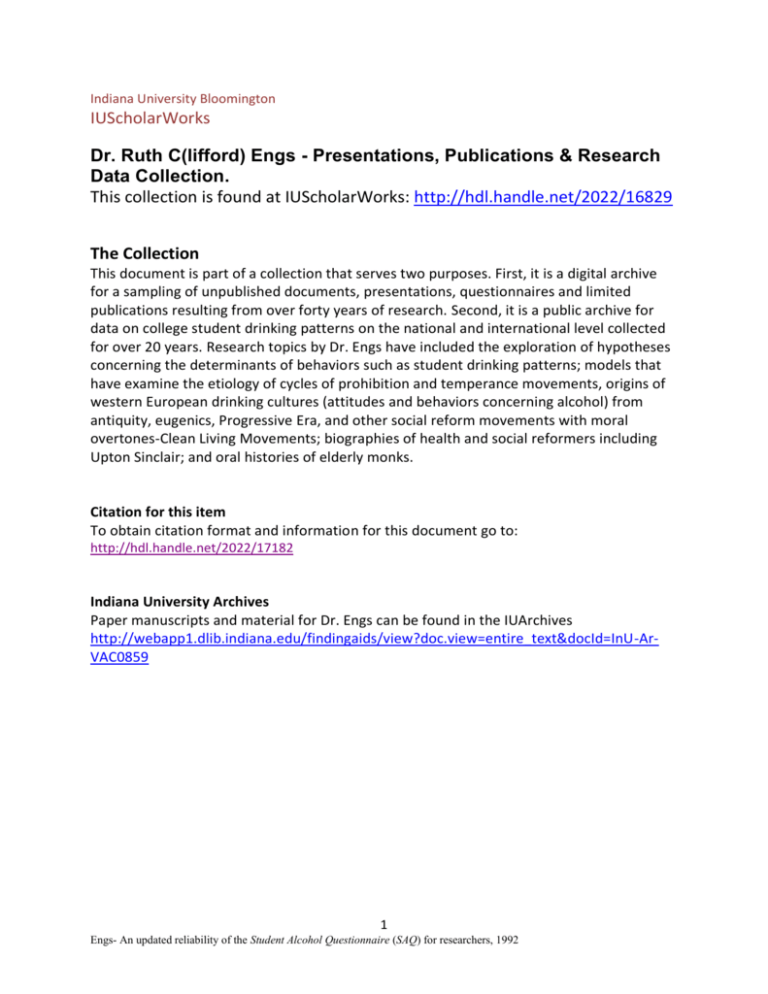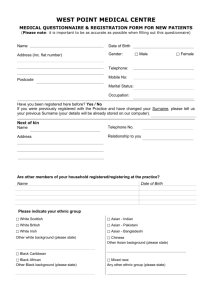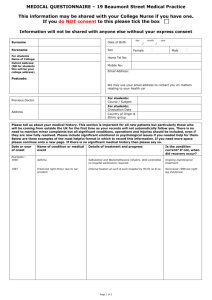IUScholarWorks Dr. Ruth C(lifford) Engs
advertisement

Indiana University Bloomington IUScholarWorks Dr. Ruth C(lifford) Engs - Presentations, Publications & Research Data Collection. This collection is found at IUScholarWorks: http://hdl.handle.net/2022/16829 The Collection This document is part of a collection that serves two purposes. First, it is a digital archive for a sampling of unpublished documents, presentations, questionnaires and limited publications resulting from over forty years of research. Second, it is a public archive for data on college student drinking patterns on the national and international level collected for over 20 years. Research topics by Dr. Engs have included the exploration of hypotheses concerning the determinants of behaviors such as student drinking patterns; models that have examine the etiology of cycles of prohibition and temperance movements, origins of western European drinking cultures (attitudes and behaviors concerning alcohol) from antiquity, eugenics, Progressive Era, and other social reform movements with moral overtones-Clean Living Movements; biographies of health and social reformers including Upton Sinclair; and oral histories of elderly monks. Citation for this item To obtain citation format and information for this document go to: http://hdl.handle.net/2022/17182 Indiana University Archives Paper manuscripts and material for Dr. Engs can be found in the IUArchives http://webapp1.dlib.indiana.edu/findingaids/view?doc.view=entire_text&docId=InU-ArVAC0859 1 Engs- An updated reliability of the Student Alcohol Questionnaire (SAQ) for researchers, 1992 AN UPDATED RELIABILITY OF THE STUDENT ALCOHOL QUESTIONNAIRE (SAQ) 1 FOR RESEARCHERS Ruth C. Engs, Professor, Department Applied Health Science, Indiana University, Bloomington, Indiana University Bloomington, IN: White Paper, 1992 Digitalized for IUScholarworks 2013. Retrieved from the IUScholarWorks repository at: http://hdl.handle.net/2022/17182 ABSTRACT The Student Alcohol Questionnaire (SAQ) was developed during the 1973-1974 academic year as part of an alcohol awareness educational program at Indiana University called Booze and You’s. Since it is frequently used by academics and students for research and classroom projects, an updated reliability was considered important. In 1990-1991, a sample of 6,534 students attending 104 different colleges and universities was used to test the reliability. Results revealed that the reliabilities of the Quantity/Frequency of drinking, Problems Resulting from Drinking, and Knowledge of Alcohol scales of the Student Alcohol Questionnaire were still highly reliable. The Spearman-Brown reliability coefficients of the subscales were .84, .89, and .85 respectively. Values of the Cronbach alpha for the three subscales were .86, .92, and .86 respectively. 1 Some parts of this paper were adapted for the following publication: R.C. Engs, and D. J. Hanson. The Student Alcohol Questionnaire: An Updated Reliability of the Drinking Patterns, Problems, Knowledge and Attitude Subscales. Psychological Reports, 74, 1994: 12-14. 2 Engs- An updated reliability of the Student Alcohol Questionnaire (SAQ) for researchers, 1992 INTRODUCTION The Student Alcohol Questionnaire (SAQ) was developed during the 1973-1974 academic year (Engs, 1975, 1977a, 1977b, 1978, 1979) as part of an alcohol awareness educational program at Indiana University called Booze and You’s. Besides demographic information, it contains subscales concerned with drinking patterns (Quantity/Frequency), problems related to alcohol, and knowledge of alcohol and its effects. As part of its development, the instrument was subjected to face validity by a panel of experts and by college students. Various reliability analyses including test-retest and internal reliability procedures were performed. Both the testretest reliability and the Kuder-Richardson reliability were .79 for the behavior and for the knowledge subscales (Engs, 1977, 1978). Since its development almost 20 years ago, the Student Alcohol Questionnaire has been used by numerous researchers who have reported their results in a variety of journals as the questionnaire has always been available without charge for educational use and academic studies. Concerns about the instrument being outdated and increased requests for updated reliability by doctoral students and researchers led to a re-evaluation of the instrument. Thus, the purpose of this paper is to determine updated estimates of reliability for the various scales of the SAQ for researchers. METHODS In 1981, David J. Hanson, Professor of Sociology, SUNY, NY, and I began a longitudinal study of undergraduate drinking behaviors. The instrument was administered in health education and sociology classes throughout the nation resulting in a convenience sample of students. Colleges and universities were selected to be representative of American institutions of higher learning in terms of enrollment, gender and racial composition, institution control or sponsorship, and community size. Whenever attrition of a college had occurred over the years, an institution from the same state, matched on the basis of the above characteristics, was substituted. Questionnaire The SAQ contains three subscales. There are 23 questions on drinking related behavior – six on the quantity and frequency of drinking beer, wine or spirits and 18 questions on problems related to drinking; 36 items knowledge of alcohol and its effects; and 11 demographic variables. Each of the three subscales were subjected to the Spearman-Brown split-half technique for internal reliability. In addition, a measure of homogeneity using the Cronbach alpha was used. An item analysis required each question in a subscale be correlated with the total score of that 3 Engs- An updated reliability of the Student Alcohol Questionnaire (SAQ) for researchers, 1992 subscale using the Pearson correlation. For all statistical procedures, SPSS programs using the Indiana University VAX (mainframe) computer cluster were applied. The Sample In 1990-1991, a sample of 6,534 students attending 104 different colleges and universities was gathered by Engs and Hanson to be used for several analyses. At each institution, sociology or health and physical education instructors, who teach survey-type classes with a high probability of containing students from every academic major and class year, were asked to administer the questionnaire to no more than 75 students in the classroom. The proportion of incomplete or otherwise unusable questionnaires was less than two percent in this convenience sample. The demographic characteristics of the students in this sample approximate those of the universe of baccalaureate college students in the USA (Statistical Abstract, 1991) except for a slightly higher proportion of female students (60%) in the sample compared to women attending colleges in the USA (58%). RESULTS Quantity/Frequency: The six items to assess the quantity and frequency index of drinking beer, wine, and spirits were subjected to the various procedures described above. The equal-length Spearman-Brown test gave a reliability coefficient of .84; the Cronbach alpha was .86. The reliabilities of the individual items ranged from .50 to .73 for this subscale. Problems Resulting from Drinking: This subscale includes such items as "driven a car while drinking," "missed a class because of hangover," and "damaged property because of drinking." The equal-length Spearman-Brown statistics for these 18 questions yielded a reliability coefficient of .89; Cronbach alpha was .92. From the item analysis reliabilities ranged from .54 to .75. Knowledge of alcohol and its effects: There are 36 "true-false" items concerning knowledge of alcohol, including such topics as "alcoholic beverages do not provide weight-increasing calories," "a person cannot become an alcoholic by just drinking beer," and "beer usually contains from 2-12% alcohol by volume." The Spearman-Brown formulae gave a reliability coefficient of .85. Cronbach alpha was .86, and the items' Pearson reliability coefficients ranged from .20 to .51. 4 Engs- An updated reliability of the Student Alcohol Questionnaire (SAQ) for researchers, 1992 It was concluded that the Student Alcohol Questionnaire, originally developed in 1974-75, is still a reliable instrument for measuring college students' drinking patterns, problems related to drinking, knowledge of alcohol, and attitudes towards alcohol. REFERENCES Engs, Ruth C. The Student Alcohol Questionnaire. Bloomington, IN: Department of Health and Safety Education, Indiana University, 1975. IUScholarWorks repository: http://hdl.handle.net/2022/17153 Engs, Ruth C. Alcohol Knowledge and Drinking Behavior at Thirteen Colleges and Universities (Development of the Student Alcohol Questionnaire). Paper Presented: American College Health Association National Conference, Philadelphia, Pennsylvania, March, 1977a. IU ScholarWorks repository: http://hdl.handle.net/2022/17181 Engs, R.C. Drinking patterns and drinking problems of college students. Journal of Studies on Alcohol, 1977b. 38, 2144-2156. Engs, R.C. College students' knowledge of alcohol and drinking. Journal of the American College Health Association, 1978, 26, 189-193. Engs, Ruth C. A National Study of Drinking Patterns among University Students. Paper presented: 32nd International Congress on Alcoholism and Drug Dependency, Warsaw Poland. September, 1979. IUScholarWorks repository: http://hdl.handle.net/2022/17154 U.S. Department of Commerce. Statistical Abstract of the U.S., National Data Book. Washington, DC: Bureau of Statistics, 1991. Pp. 171-172. 5 Engs- An updated reliability of the Student Alcohol Questionnaire (SAQ) for researchers, 1992







